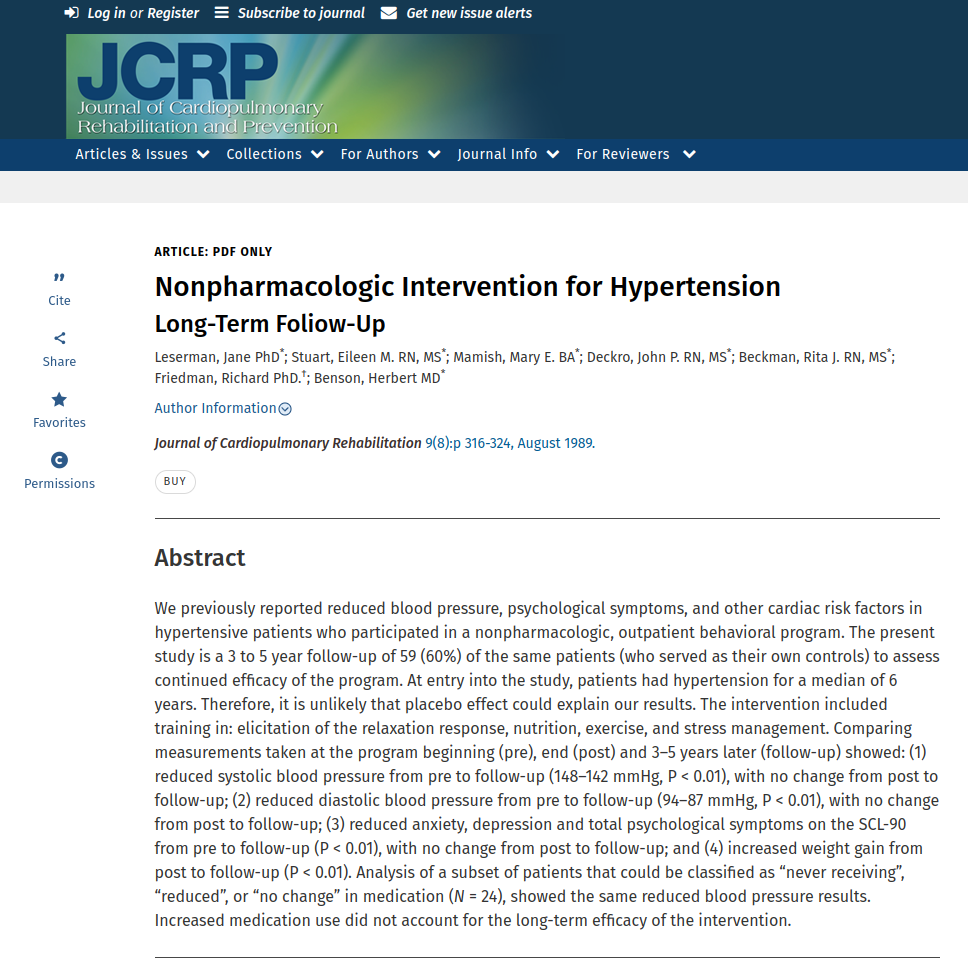We previously reported reduced blood pressure, psychological symptoms, and other cardiac risk factors in hypertensive patients who participated in a nonpharmacologic, outpatient behavioral program. The present study is a 3 to 5 year follow-up of 59 (60%) of the same patients (who served as their own controls) to assess continued efficacy of the program. At entry into the study, patients had hypertension for a median of 6 years. Therefore, it is unlikely that placebo effect could explain our results. The intervention included training in: elicitation of the relaxation response, nutrition, exercise, and stress management. Comparing measurements taken at the program beginning (pre), end (post) and 3–5 years later (follow-up) showed: (1) reduced systolic blood pressure from pre to follow-up (148–142 mmHg, P < 0.01), with no change from post to follow-up; (2) reduced diastolic blood pressure from pre to follow-up (94–87 mmHg, P < 0.01), with no change from post to follow-up; (3) reduced anxiety, depression and total psychological symptoms on the SCL-90 from pre to follow-up (P < 0.01), with no change from post to follow-up; and (4) increased weight gain from post to follow-up (P < 0.01). Analysis of a subset of patients that could be classified as “never receiving”, “reduced”, or “no change” in medication (N = 24), showed the same reduced blood pressure results. Increased medication use did not account for the long-term efficacy of the intervention.
Nonpharmacologic Intervention for Hypertension Long-Term Foliow-Up
Publication
Journal of Cardiopulmonary Rehabilitation
9(8):p 316-324
Abstract
Web and Email Links
Related Listings
Journal
Nature
Social-evaluative stressors—experiences in which people feel they could be judged negatively—pose a major threat to adolescent mental health1,2,3 and can cause young people to disengage from stressful pursuits, resulting in missed opportunities to acquire valuable skills. Here we show that replicable benefits for the stress responses of adolescents can be achieved with a short (around 30-min), scalable 'synergistic mindsets' intervention. This intervention, which is a self-administere […]
Journal
The International Journal of Psychiatry in Medicine
It is hypothesized that situations requiring continuous behavioral adjustment activate an integrated, hypothalamic response, the emergency reaction. The frequent elicitation of the physiologic changes associated with the emergency reaction has been implicated in the development of diseases such as hypertension. Prevention and treatment of these diseases may be through the use of the relaxation response, an integrated hypothalamic response whose physiologic changes appear to be the cou […]
Journal
The Journal of Nervous and Mental Disease
A cross-sectional national telephone survey was used to determine whether Christian Scientists (N = 230), a religious group that uses mind/body (including spiritual) healing, self-report more or less illness than non-Christian Scientists (N = 589). The primary outcome measure was the proportion of Christian Scientists and non-Christian Scientists that, during the previous 12 months: a) experienced any of 13 common medical conditions or symptoms; and b) used conventional medicine, unco […]

